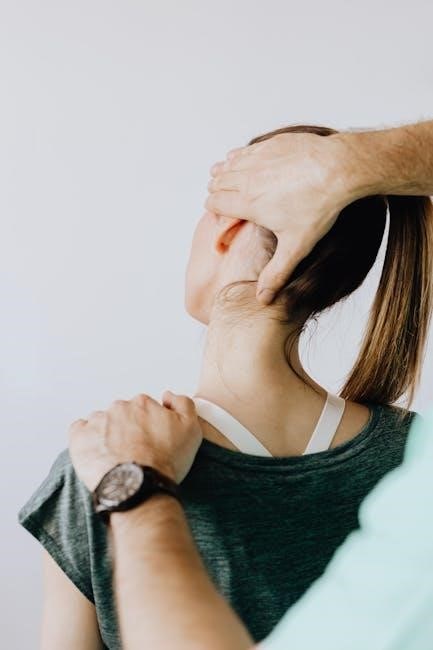Overview of Adductor Strains
Adductor strains involve tears or stretches in the groin muscles‚ often caused by sudden movements or overuse. They are common in athletes and require structured rehabilitation.
1.1. Understanding the Injury
An adductor strain occurs when one or more of the groin muscles (adductor magnus‚ adductor longus‚ or adductor brevis) are stretched or torn‚ often due to sudden twisting or overuse. The injury is classified into three grades: mild (Grade 1)‚ moderate (Grade 2)‚ or severe (Grade 3)‚ with Grade 3 involving a complete muscle tear. Symptoms include pain‚ swelling‚ and limited mobility. Proper diagnosis and early intervention are crucial to prevent complications and ensure a full recovery. Understanding the injury’s severity and affected muscles is key to developing an effective rehabilitation plan.
1.2. Common Causes and Symptoms
Adductor strains often result from sudden movements‚ such as twisting or changing direction‚ or repetitive overuse in sports like football and hockey. Symptoms typically include localized groin pain‚ swelling‚ and tenderness. Athletes may experience limited mobility‚ difficulty walking‚ or pain during activities like kicking or sprinting. In severe cases‚ a popping sensation or significant bruising may occur. Early recognition of these symptoms is critical for proper diagnosis and timely intervention to prevent further damage and promote recovery.

Importance of a Structured Rehabilitation Protocol
A structured rehab protocol ensures proper healing‚ reduces complications‚ and minimizes re-injury risk. It provides a clear‚ evidence-based approach to restore strength‚ mobility‚ and function safely.
2.1. Benefits of a Rehab Protocol
- Ensures proper healing by addressing muscle imbalances and promoting tissue repair.
- Reduces risk of complications such as chronic pain or prolonged recovery.
- Restores strength and flexibility gradually‚ preventing re-injury.
- Provides a clear progression of exercises tailored to individual needs.
- Enhances functional recovery for return to daily activities or sports.
- Incorporates pain management strategies to improve comfort during rehab.
- Minimizes downtime with a structured‚ evidence-based approach.
2.2. Goals of the Protocol
The primary goals of an adductor strain rehabilitation protocol include restoring normal muscle function‚ eliminating pain‚ and preventing re-injury. The protocol aims to improve strength‚ flexibility‚ and range of motion while addressing muscle imbalances. It seeks to gradually reintroduce physical activity‚ ensuring a safe transition back to sports or daily activities; By focusing on progressive exercises and pain-free movements‚ the protocol helps athletes achieve full recovery and maintain long-term muscle health. Individualized approaches ensure the program is tailored to specific needs and injury severity‚ promoting optimal outcomes and reducing the risk of future strains.

Phases of Rehabilitation
Rehabilitation is divided into three phases: acute (0-72 hours)‚ intermediate (72 hours to 2 weeks)‚ and advanced (2 weeks and beyond)‚ each tailored to injury severity and recovery progress.
3.1. Acute Phase (0-72 Hours)
The acute phase focuses on minimizing pain and inflammation. Immediate measures include rest‚ ice‚ compression‚ and elevation (RICE principle). Gentle isometric exercises and pain-free stretching are introduced to maintain mobility without aggravating the injury. This period emphasizes protecting the adductor muscles from further strain‚ ensuring proper healing‚ and preparing for the next phase of rehabilitation. Activities should avoid pain provocation‚ prioritizing tissue repair and reducing muscle spasms. This phase sets the foundation for a gradual and safe progression to more intense exercises in subsequent stages.
3.2. Intermediate Phase (72 Hours to 2 Weeks)
During this phase‚ focus shifts to restoring flexibility and strength. Gentle stretching‚ such as adductor stretches‚ and low-intensity exercises like swimming or cycling are introduced. Pain-free isometric exercises‚ including adductor squeezes‚ are prioritized to enhance muscle activation without strain. Progressive resistance is gradually added to improve muscle endurance. Dynamic movements are cautiously incorporated to prepare for functional activities. The goal is to restore muscle balance‚ reduce stiffness‚ and advance toward weight-bearing exercises‚ ensuring a smooth transition to the advanced phase while avoiding re-injury.
3;3. Advanced Phase (2 Weeks and Beyond)
In the advanced phase‚ focus shifts to dynamic exercises‚ sports-specific movements‚ and functional activities. High-intensity interval training‚ agility drills‚ and resistance exercises are introduced to restore full strength and endurance. Core stability and balance training are emphasized to improve overall athleticism. Patients progress to weight-bearing exercises and plyometric activities‚ ensuring proper movement patterns. Modalities like therapeutic ultrasound may be used to support recovery. The goal is to prepare the athlete for a safe return to sport by enhancing power‚ speed‚ and reestablishing muscle memory‚ while minimizing the risk of re-injury.
Exercise Progression
Exercise progression begins with gentle stretching‚ advancing to strengthening exercises‚ and finally incorporating functional‚ sports-specific movements to restore full mobility and strength.
4.1. Stretching and Mobility Exercises
Stretching and mobility exercises are critical for restoring flexibility and reducing stiffness in the adductor muscles. Begin with gentle hip adductor stretches‚ lying on your back with knees bent and feet flat. Slowly lower your knees apart while maintaining control. Seated groin stretches and butterfly stretches are also effective. These exercises should be performed pain-free‚ focusing on controlled movements. Incorporate exercises like lateral lunges and leg swings to enhance mobility. Gradually increase the intensity as comfort allows. Cycling on a stationary bike is another excellent way to improve active mobility without strain.
4.2. Strengthening Exercises
Strengthening exercises are vital for rebuilding adductor muscle strength post-injury. Begin with isometric exercises like adductor squeezes‚ holding for 5-10 seconds. Progress to side-lying leg lifts and seated adductions using resistance bands or cable machines. These exercises target the adductor magnus and brevis muscles. Incorporate core stability exercises to enhance overall lower limb stability. Perform these exercises 1-2 times daily‚ gradually increasing resistance as strength improves. Avoid pain during exercises to prevent re-injury. Focus on controlled movements to ensure proper muscle engagement and progression.
4.3. Functional and Sports-Specific Exercises
Functional and sports-specific exercises are designed to mimic real-life movements‚ preparing the athlete for return to play. Examples include lateral shuffles‚ carioca drills‚ and single-leg balance exercises to enhance agility and stability. Progress to controlled‚ sport-specific movements like simulated kicking or directional changes. These exercises improve muscle coordination and reduce the risk of re-injury. Perform them in a pain-free range‚ gradually increasing intensity and complexity. The goal is to restore functional strength and confidence‚ ensuring a safe and effective transition back to athletic activities.

Pain Management Strategies
Pain management focuses on reducing discomfort and inflammation using modalities like therapeutic ultrasound‚ laser‚ and dry needling. Medications‚ such as NSAIDs‚ may be prescribed to alleviate symptoms. Activity modification is essential to avoid exacerbating the injury‚ ensuring pain-free recovery and preventing further strain.
5.1. Modalities and Medications
Therapeutic modalities such as ultrasound‚ laser therapy‚ and dry needling are commonly used to reduce pain and inflammation in adductor strains. Nonsteroidal anti-inflammatory drugs (NSAIDs) are often prescribed to manage pain and swelling. These treatments are typically applied during the acute and intermediate phases to promote healing and improve mobility. It’s important to use these interventions under medical supervision to avoid side effects and ensure they complement the rehabilitation process effectively.
5.2. Activity Modification
Activity modification is crucial during the rehabilitation of adductor strains to avoid aggravating the injury. Patients are advised to avoid movements that cause pain‚ such as sudden twists or kicks. Temporary cessation of high-impact sports and activities that involve repetitive groin strain is recommended. Gentle‚ low-impact exercises like cycling or swimming can be introduced gradually. Using supportive devices‚ like compression shorts or braces‚ may help reduce stress on the adductor muscles. A gradual return to normal activities ensures proper healing and minimizes the risk of re-injury.

Returning to Sport
Athletes can return to sport when they achieve full strength‚ flexibility‚ and pain-free performance in functional movements. Gradual reintroduction of sports-specific activities is essential to prevent re-injury.
6.1. Criteria for Safe Return
Athletes can safely return to sport when they exhibit no pain during daily activities or sports-specific movements. Full strength‚ flexibility‚ and functional ability must be restored. They should demonstrate pain-free‚ full-range motion and achieve near-normal or greater strength compared to the uninjured side. Functional testing‚ such as sprinting‚ cutting‚ and pivoting‚ should be performed without discomfort. Clearance from a medical professional is often required to ensure readiness. Gradual progression into full activity prevents re-injury‚ ensuring a durable return to competition.
6.2. Gradual Reintegration into Sports Activities
Gradual reintegration into sports involves progressing from controlled drills to dynamic‚ sport-specific movements. Start with low-intensity exercises‚ ensuring no pain or discomfort. Progress to agility drills‚ such as cutting and pivoting‚ and then to explosive actions like sprinting. Incorporate sport-specific skills‚ like dribbling or shooting‚ while maintaining proper technique. Monitor for any signs of fatigue or discomfort and adjust the intensity accordingly. Full integration occurs when the athlete demonstrates consistent performance and confidence in all aspects of their sport‚ with clearance from a healthcare provider.

Preventing Re-injury
Preventing re-injury involves strengthening‚ flexibility‚ proper warm-ups‚ and technique. A personalized program‚ gradual progression‚ and avoiding overtraining are essential for long-term recovery and injury avoidance.
7.1. Strengthening and Flexibility
Strengthening and flexibility exercises are crucial for preventing re-injury. Focus on adductor-specific stretches‚ such as the seated adductor stretch and hip adductor stretch‚ to improve range of motion. Incorporate isotonic exercises‚ like adductor machine work‚ to enhance muscle strength. Core stability and functional movements‚ such as lunges and step-ups‚ should also be included to promote overall lower limb balance. Exercises should be pain-free and progressed gradually to avoid overload. Consistency in a structured program‚ 2-3 times weekly‚ ensures sustained muscle integrity and joint mobility‚ reducing the risk of future strains.
7.2. Proper Warm-Up and Cool-Down
A thorough warm-up and cool-down are essential for preventing re-injury and maintaining muscle health. Start with dynamic stretches‚ such as leg swings and lunges‚ to activate the adductors and surrounding muscles. Incorporate light cardio‚ like cycling or jogging‚ to increase blood flow. Post-exercise‚ focus on static stretches for the adductors‚ hamstrings‚ and hip flexors‚ holding each for 20-30 seconds. Foam rolling and self-myofascial release can also aid in muscle recovery. Consistency in these routines helps maintain flexibility‚ reduces muscle tension‚ and lowers the risk of future strains‚ especially in athletes.
A structured rehabilitation protocol is essential for effectively managing adductor strains. Adherence to guidelines ensures optimal recovery and minimizes re-injury risks‚ promoting long-term muscle health and functionality.

8.1. Summary of Key Points
A well-structured rehabilitation protocol is crucial for effectively managing adductor strains‚ ensuring optimal recovery‚ and minimizing the risk of re-injury. Key components include a phased approach‚ incorporating stretching‚ strengthening‚ and functional exercises tailored to the individual’s progress. Pain management strategies and activity modification are essential to support the healing process. Clear criteria for returning to sport and maintaining long-term muscle health are critical. Adherence to these guidelines‚ coupled with proper warm-up and cool-down routines‚ enhances recovery outcomes and prevents future injuries.
8.2. Final Thoughts on Recovery
Recovery from an adductor strain is a journey requiring patience‚ dedication‚ and adherence to a well-structured rehabilitation protocol. A comprehensive approach addressing pain management‚ strengthening‚ and functional exercises ensures optimal outcomes. Consistency in following the protocol‚ coupled with proper warm-up and cool-down routines‚ is vital. It’s important to stay positive and avoid rushing the process‚ as premature return to activity can lead to re-injury. With time and commitment‚ most individuals can achieve a full recovery and safely return to their sport or daily activities.
